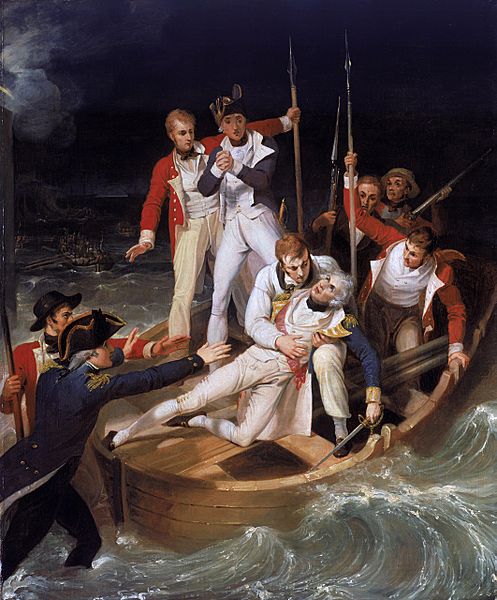Image: Sir Horatio Nelson when wounded at Teneriffe

Description: In the painting, Nelson's barge is shown beached in the surf, in port-bow view. Hit on the point of landing he reeled and staggered back into the boat where he lies, having transferred his sword to his left hand. He is supported by a sailor and there is blood on the sailor's shirt and on the lining of Nelson's coat. Lieutenant Josiah Nisbet, Nelson's stepson, stands behind him and is saving his life by staunching the blood. Behind him and to the left are two other lieutenants. Also in the barge and to the right of the group is a third lieutenant grasping a boarding pike, with two sailors behind him. In the left foreground standing in the shallow water is Captain Thompson, arms outstretched towards Nelson, together with another lieutenant. In the left background is a bow view of another boat approaching the beach. In the right foreground the artist has used the waves to enhance the dramatic impact. Westall has conveyed the staged effect by employing a dramatic language of gesture and expression. This painting of the incident was made in 1806. It was commissioned by John M'Arthur, as a plate for 'The Life of Admiral Lord Nelson, KB', which he published with James Stanier Clarke in 1809, and which was the first major biography of Nelson. Engraved by J. Neagle in 1809, it formed part of a series of five painted for the book by Westall, all intended to show Nelson's life as a series of heroic acts. With two by West, also used in the same way (BHC0566 and BHC2905), and Lemuel Abbott's best-known portrait of Nelson (BHC2889) all were presented to Greenwich Hospital in 1849 'by Jasper de St Croix, Esq., and several other patriotic individuals'.
Title: English: Nelson wounded at Tenerife, 24 July 1797
Credit: National Maritime Museum website
Author: Richard Westall
Permission: This is a faithful photographic reproduction of a two-dimensional, public domain work of art. The work of art itself is in the public domain for the following reason: This work is in the public domain in its country of origin and other countries and areas where the copyright term is the author's life plus 100 years or less. You must also include a United States public domain tag to indicate why this work is in the public domain in the United States. This file has been identified as being free of known restrictions under copyright law, including all related and neighboring rights. The official position taken by the Wikimedia Foundation is that "faithful reproductions of two-dimensional public domain works of art are public domain". This photographic reproduction is therefore also considered to be in the public domain in the United States. In other jurisdictions, re-use of this content may be restricted; see Reuse of PD-Art photographs for details.
Usage Terms: Public domain
License: Public domain
Attribution Required?: No
Image usage
The following 5 pages link to this image:

